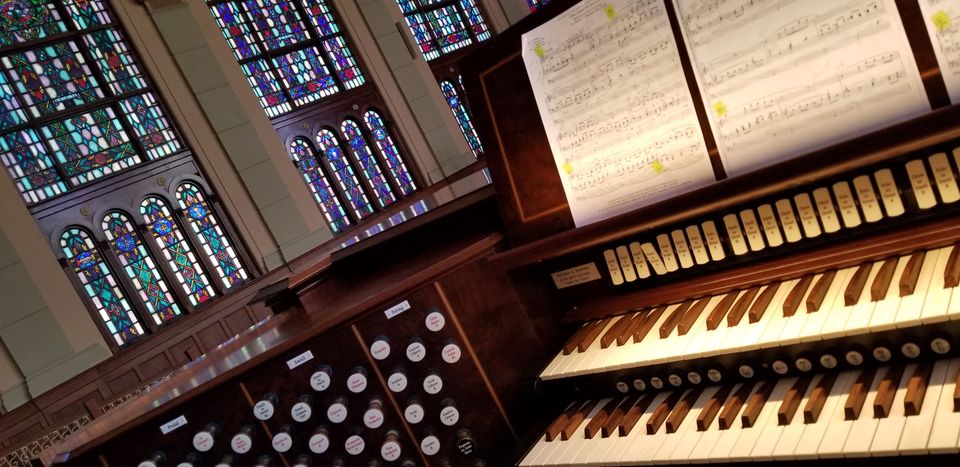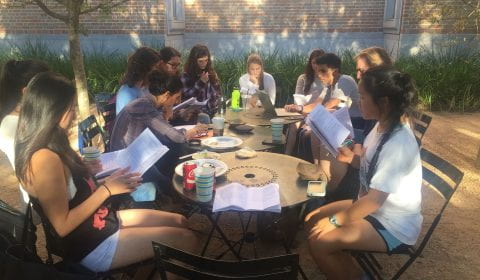my organ performances (sorted by playlist, my compositions at bottom)

To listen to all the recordings, click on the playlist button at the top right of each video screen. It will give you a list of videos to choose from. That button looks like this:

Tate on the Nichols and Simpson pipe organ at South Main Baptist Church in Houston, TX
Hauptwerk Virtual Pipe Organ
Christmas Organ Music
AGO Service Playing Certificate
All my Pipe Organ Music
Tate on the Van Daalen pipe organ at the University of Minnesota
Tate on the Fisk-Rosales, Edyth Bates Old pipe organ at Rice University
Tate on the Grace University Lutheran Church pipe organ in Minneapolis, MN
This performance was also featured on the American Guild of Organists' Young Organists Women Composers Project
my compositions
The Prodigal Son
The first piece I wrote for the organ! Part of an assignment for music theory class.
Final composition project for MUSI 317 at Rice University Composed and performed by Tate Shannon
The piece follows the familiar parable of the same title as the younger of two sons asks for his inheritance and leaves home only to fall into the temptation of wild living. At a climactic moment, the young son goes immediately from the top of the world to poverty, longing even to eat the food of pigs to fill his empty belly. While in the depths of despair, he remembers his merciful father and returns home expecting to be taken in as a servant but instead finds an enormous party thrown in honor of his return
La Triste Figura (Don Quijote)
This is the second piece I wrote for school and the first performed on the personal organ I built. It was inspired by and written for the class I took on the book Don Quijote. (Click the link to watch. I included a translation below!)

La Triste Figura (musical work) Written and translated by Tate Shannon
Prologue
Disinterested listener:
Without my taking an oath, you may believe me that I would wish this work to be the most beautiful, the most gallant, and the most discreet that could be imagined; but the sands of history tell us that the genius of Cervantes, to this day, remains unparalleled among us mortals.
In this musical work, we follow the Knight of the Sad Countenance from La Mancha to the high mountains of Sierra Morena; from the open and free plains to the dense and enchanted forests. We hear vignettes about the beauty of love and the ugliness of society and the human condition. Our protagonist, Don Quijote, goes in search of great adventures with his noble steed Rocinante and his loyal squire Sancho Panza. We see him face giants, princesses, armies, and castles... while Sancho can only see windmills, working women, sheep, and innkeepers because there are enchanters working against the legendary duo. Come with us to discover this enchanted adventure of the Golden Age of knight errantry in which prostitutes become princesses, ladies become shepherdesses, and the whole world is transformed into the impossible dreams of our valiant Knight of the Sad Figure.
This musical score is intended for the organ, the only instrument as great and enigmatic as Don Quijote and its author Miguel de Cervantes. The organ can replicate the sounds of all other instruments, from the strings in an orchestra to the trumpets, clarinets, and flutes in a band. It can whisper as a breath or roar to declaim the story of our protagonist.
Chapter One: Which deals with the call of the books of chivalry to Alonso Quijano.
In this first chapter, we begin with some great sighs of the protagonist. The strings here show the boredom and feeling of life without purpose. The strings continue non-stop throughout the chapter, but the trumpets of the knights' call drown out Alonso Quijano's thoughts at the beginning and resonate until the end. Quijote's theme (the first melody we hear, about 1.5 minutes into the movement) gradually combines with the trumpets of the great knights of the story and creates its own adventures in the chapters that follow.
The first variation is a scene when Alonso Quijano looks at his nag and gives it the name Rocinante. Just after Alonso Quijano's sighs express depression, they gradually come to represent anticipation as the knight thinks of the steed's strength and bravery.
A slight sadness returns when Alonso Quijano sees that he needs a reason to live and fight against the evil and cruelty of the world: he needs a princess to whom he can dedicate his heart and work. The second time we hear Don Quixote's theme (this time thinner and more yearning than before) is when he finds the light of his life, the peerless Dulcinea del Toboso!
Now, with the third variation of the theme, we continue with more force, but now it is a conversation between Don Quijote and his family and friends who prefer that he stay at home without venturing out like a madman. They use reasonable and logical words, but Don Quixote's determination is absolute when he thinks of his beloved Dulcinea.
In the last part, the Quijote theme shows that now Alonso Quijano is dead and in his place, the one and only never-sufficiently-praised knight Don Quixote de la Mancha lives!

